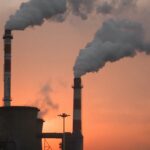The recent climate conference at Glasgow (COP26) ended in a hassle, bringing the commitments, targets, and efforts of Europe as a regional entity to the forefront.
It was not far in history when discussions on climate change at an international level gained momentum in the 1970s significantly after the Stockholm Conference of 1972. Let us go back to the 1800s.
Coal became the primary energy source through the industrial revolution. City life boomed with a population explosion. Hike in the burning of coal and other combustions was directly proportional to the rate of greenhouse gas emissions.

What is the need to give this brief historical introduction while discussing the European Green Deal? Presently, most of us are well aware that global warming-induced climate change will be the executioner of life on Earth. However, people (politicians and billionaires) still see this phenomenon as a money-making business.
In 1896, Svante Arrhenius, a Swedish scientist, forecasted that the greenhouse effect through CO2 emissions from coal-burning would result in global warming. Nevertheless, for him, this increase in temperature was good because he predicted that this could be helpful for agriculture.
We have come a long way forward. However, climate change has started to show its impact on our daily lives. In light of this, let us take a look at the European Union’s master plan to combat this impending disaster.
The article focuses on what the EU economy can gain from it and the role of carbon trading in achieving the goal.

EUROPE’S NET-ZERO GOALS
Among the Kyoto Protocol signatories, the EU belonged to Annex I countries. Annex I countries are those which are responsible for most CO2 emissions. These nations are required to cut back their carbon emissions. The only signatory to fulfill the protocol conditions was the EU.
Europe had a 20% fall in carbon emissions between 2000 and 2017. Nevertheless, this achievement was primarily by relocating the bloc’s manufacturing industry to other parts of the globe. However, the cuts were not enough to combat climate change.

Reaching a climate agreement is somewhat tricky. A binding agreement among the parties was a challenge at both the 2015 Paris Conference and the 2021 COP26.
So, the EU’s initiatives are substantial for devising a plan where many nations have failed.
The European Union approved the European Green Deal in December 2019. The European Commission President described it as “Europe’s man on the moon moment”. The plan consists of two major transitions:
- Decarbonisation
- Digitalizing Europe’s economy

This deal is not legal but a plan on Europe’s approaches and legislations to attain sustainability.
Tackling climate change is undoubtedly an arduous task. Inarguably, the natural world has been the victim of man’s relentless exploitation. The European Green Deal is the EU’s policy initiative to compensate for the centuries-long abuse of nature. According to the European Commission, the primary objectives of the green deal are
- to become the first climate-neutral continent by 2050 by depending more on renewable energy
- to check economic growth through resource exploitation
- to foster an inclusive green transition
BOOST TO EMPLOYMENT OPPORTUNITIES IN EUROPE
The sustainability track of the EU will have a direct impact on both economic activities and employment opportunities in the region.

According to a McKinsey analysis, five sectors have a significant share of carbon emissions. Namely, power, transportation, building industry, and agriculture. So, these sectors will have to undergo large-scale transformations to achieve the EU goal.
Changes in these sectors may cause a sudden but short setback to employment. Nonetheless, studies have assessed that inaction in tackling climate change and environmental degradation could cause a risky fall in the annual GDP of the EU in future years. Environment sustainability and economic growth indeed are synergic. Thus, the EU can benefit from its climate action plan.

The green economy has the potential for job creation. A decarbonised economy will not be one of unemployment. However, the employees in a net-zero economy will be dramatically different from the current ones. In light of this, the EU has to make great efforts to reskill its workers to manage energy transition effectively.
As per the projections made by McKinsey, by 2050, around 11 million jobs will be created. For instance, the most vulnerable to the transition, the power sector will have a 66% rise in employment; 700,000 and 450,000 jobs in solar and wind, respectively.
Similarly, the building sector also reflects such a trend. Around 50% of infrastructure in the EU, particularly in the Nordic regions, including houses, will require more insulation to be energy efficient. This creates new opportunities for skilled workers.

Thus, both EU bloc governments and employers should take steps to build a capable workforce for a carbon-neutral economy.
ECONOMIC GROWTH OF THE BLOC
The latest technological developments are the prerequisite for a zero-carbon economy. The efforts to shift the EU into carbon-neutral can open new industrial opportunities that boost the economy.
Newmarket opportunities include electric vehicles, high-capacity batteries, etc. Also, urban planning will need to make the cities more compatible with the green economy.
Climate change mitigation will directly benefit the people and the national governments from a broader perspective. Reducing natural disasters like floods and other extreme weather conditions are examples.

To cite, the July 2021 floods in Germany had detrimental effects on its economy before a national election. There were widespread criticisms and questions on why Europe’s largest economy was caught off guard by the flood.
European businesses have an optimistic approach to the Green Deal. Primary reasons for this include:
- climate action can unlock a digital innovation
- employment will rise in industrial ecosystems
- climate neutral infrastructure like e-charging facilities will gain popularity
EU EMISSIONS TRADING SYSTEM (EU ETS)
Curbing the Green House Gases (GHG) building is crucial to minimise climate change adversities. Even the global companies show a consensus that the developed nations are the ones to take immediate actions. They stress the need for “a robust global greenhouse gas emissions market”.

The 1997 Kyoto Conference laid out the possibility of a carbon market. More than 30 countries voluntarily adopted schedules to reduce GHG emissions as part of the Kyoto Protocol.
Thus, carbon became a commodity creating a carbon market. The European Union’s Emissions Trading System, set up in 2005, is the first international emissions trading system. It is also the largest in operation currently. The EU ETS is based on the ‘cap and trade’ principle.
What are Cap and Trade?
“Under cap-and-trade schemes, governments or intergovernmental bodies set an overall legal limit of carbon emissions in a certain time period (“a cap”) and then grant industries a certain number of licenses to pollute (“carbon permits”).
Companies that do not meet their cap can buy permits from others that have a surplus typically because they have been given an overly generous allowance in the first place. “1

The EU ETS covers three gases that cause a high level of emissions. They include carbon dioxide (CO2), nitrous oxide (N2O), and perfluorocarbons (PFCs). Therefore, companies that produce these gases should mandatorily be a part of EU ETS. For example, the electricity sector, energy-intensive industry, aviation sector, etc.
The system is now in its fourth phase (2021-2030). During its second phase (2008-2012), the ETS succeeded in its Kyoto protocol commitment reducing GHG emissions to 8% compared to the 1990 levels.
A 43% reduction in emissions has been achieved through power generation and energy-intensive industries. The EU aims at a 55% reduction in carbon emissions by 2030 on the backdrop of the ‘Fit for 55’ package. Hence, ETS is considered the core tool to achieve the 2030 target and transform the bloc into a carbon-neutral one by 2050.
A Booming Carbon Market at The EU

The COP26 could not be considered an entirely successful meeting on many grounds. Nations still find it difficult to reach an agreement regarding climate change.
However, following the conference’s conclusion, the Carbon prices in the EU have doubled since early 2021. As of December 8, 2021, Reuters has reported that the carbon benchmark reached a record price of 90.75 Euros.
CHALLENGES TO THE EU
The EU aims at a radical transformation. Henceforth, devising the 2050 plan is an uphill task. The primary challenges which the EU has to overcome on the way forward are as follows:

- Chances of a rise in fuel prices are high, negatively impacting the public’s responses. France’s Yellow Vest protest was a response to similar concerns. So, governments should have welfare policies to support their citizens.
- East European nations depend heavily on fossil fuels. EU should deliver the promised financial incentives to these nations for the green transformation.
- Estimated cost of the plan is 1 trillion euros. BREXIT was a slap on the EU budget. However, it is unsure whether the proposed amount can cover the entire cost. Hence, the EU has to find measures to fill the BREXIT gap.
- The EU is dependent on the private sector. It has to be careful to avoid the carbon financiers gaining from the system.
- Supporting the developing nations with monetary contributions and technology fulfiling their environmental commitments.

CONCLUSION
To sum up, it is high time nations should reach a consensus on regulating global warming-induced climate change. When the climate is being politicised like never before, all developed countries must hold hands with the EU in the fight.
Moreover, the West should be accountable to make a more inclusive plan supporting the developing and under-developed economies. A welcoming step can be ratifying environmental treaties by the USA and showing the world its commitment, not by just hollow promises but examples.
You may also like this UKRAINE AND THE POSSIBILITY OF AN ALL-OUT WORLD WAR
About the Author
RIYA PETER.

Born and raised in Kerala, Riya Peter has always dreamed of exploring life beyond a traditional Malayali lifestyle. She has completed her Masters in Politics and International Relations from Mahatma Gandhi University, Kottayam. She is profoundly interested in European Politics and keenly focused on security and diplomacy from both European and international standpoints.







Nice work 👍
Great work
[…] You may also like this THE GREEN DEAL: EUROPE AND ITS DREAM OF CLIMATE NEUTRALITY […]
[…] You may also like to read: THE GREEN DEAL: EUROPE AND ITS DREAM OF CLIMATE NEUTRALITY! […]
[…] You May Also Like This: THE GREEN DEAL: EUROPE AND ITS DREAM OF CLIMATE NEUTRALITY […]
[…] THE GREEN DEAL: EUROPE AND ITS DREAM OF CLIMATE NEUTRALITY […]